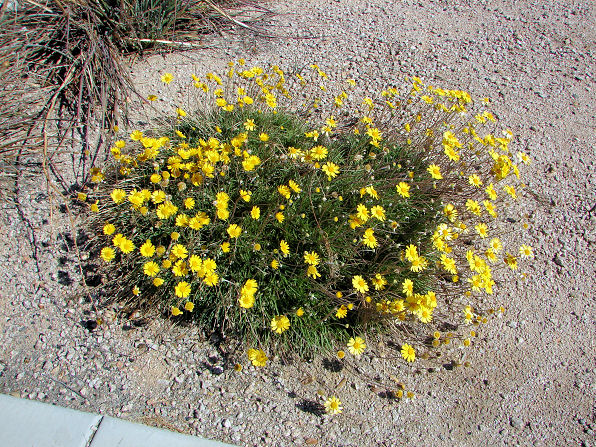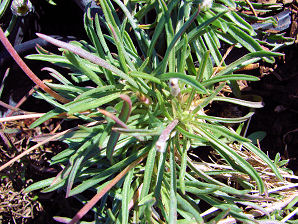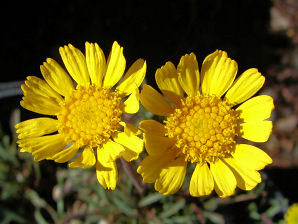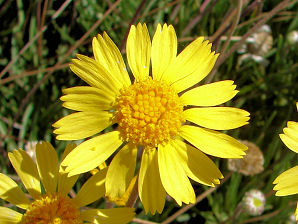Xeriscape Landscaping Plants For The Arizona Desert Environment.
Pictures, Photos, Information, Descriptions,
Images, & Reviews.
Perennials.
Angelita Daisy, Tetraneuris acaulis.
We Are Proud Of Our SafeSurf Rating!
Click On Any Of The Following Links By Amazon.Com
For Books, & Videos About Wildflowers Of Arizona & The Southwest USA. No Obligation!
 |
| Angelita Daisy. Tetraneuris acaulis. Glendale, Arizona, February 12. 2008. |
|---|
 |  |
| Angelita Daisy. Tetraneuris acaulis. | Angelita Daisy. Tetraneuris acaulis. |
|---|---|
 |  |
| Angelita Daisy. Tetraneuris acaulis. | Angelita Daisy. Tetraneuris acaulis. |
 /
/

Angelita Daisy. Tetraneuris acaulis, Aster or Sunflower Family ( Asteraceae ) also known as the Composite Family: ( Compositae ), Angelita Daisy. Also Called: Hymenoxys acaulis, Actinea acaulis, Gaillardia acaulis, Sundancer Daisy, Stemless Woollybase, Stemless Rubberweed, Perky Sue, Plains Hymenoxys, Lakeside Daisy, Manitoulin Gold, Rubberweed, or Stemless Hymenoxys. We wish to thank Wikipedia, the free encyclopedia for some of the information on this page. We share images and information with Wikipedia. A perennial native to the southwestern USA, where it occurs most often at elevations from 4000�7000 feet, on dry rocky slopes and mesas. Angelita Daisy's foliage is green and the flower is a deep gold color. It forms rounded clumps up to 12 inches tall and 5 feet wide, Hymenoxys acaulis is often used as a border in front of larger shrubs. In Phoenix, this plant blooms from late winter through early fall. Angelita daisy seems to prefer well-drained soils and full sun. It is very cold hardy, heat tolerant, and drought tolerant.
Quick Notes:
Height: Grows into in a loose mound up to about 1 foot tall and 3 - 5 feet wide.
Flowers: Two-inch, golden-yellow flower heads appear at the ends of branches. Flowers are composed of 5 to 15 oblong rays 0.12� to 0.8� long surrounding the golden disk 0.24� to 0.8� wide.
Blooming Time: February to November.
Leaves: Green thread-leaf foliage; alternate; simple; entire; has hairs at the base, 0.16� to 2.4� long, 0.04� to 0.32� wide.
Found: The USDA claims it is native to the USA (CO, ID, KS, MT, ND, NE, NM, OK, SD, TX, WY). Also native to Canada (AB, SK). Hymenoxys acaulis is also native to Chihuahua, & Coahuila Mexico. There is a sub species native to Arizona.
Elevation: 0 - 7,000 feet. Naturally at 4,500 to 7,500 Feet. Does well at lower elevations but needs water.
Hardiness:
Soil pH requirements:
Sun Exposure:
Habitat: Sandy, well-drained/light desert soils. An ideal xeriscape garden landscape plant in Arizona.
Miscellaneous: Flowering Photos Taken Glendale, Arizona, February 12. 2008.
|
We Are Proud Of Our SafeSurf Rating!



We Are Proud Of Our SafeSurf Rating!
Click On Any Of The Following Links By Amazon.Com
For Books, & Videos About Xerioscape Plants Of Arizona & The Southwest USA. No Obligation!
Click On Any Of The Following Links By Amazon.Com
For Books, & Videos About Wildlife Of Arizona & The Southwest USA. No Obligation!
Back To Arizona Xeriscape Landscaping Main Page.
Back To Xeriscape Perennials Page Three.
Back To Arizona Wild Flowers Home Page
Back To DeLange Home Page
© 1966 - Present, Audrey, Eve, & George DeLange
| © 1966 - Present, Audrey, Eve, & George DeLange |


